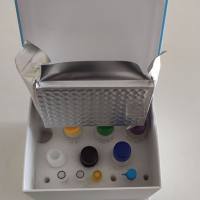Generating stable cell lines in HEK293
互联网
Generating stable cell lines in HEK293
-
Prior to transfection, it is recommended that you linearize your pcDNA gene construct. Linearizing will decrease the likelihood of the vector integrating into the genome in a way that disrupts the gene of interest or other elements required for protein expression. Suitable restriction enzymes for linearization are: Bg lII, MfeI, Pvu I, Sca I => for further, check Invitrogen pcDNA3.1 literature
-
Transfect cells in dishes of 6 cm diameter according to the protocol for transient transfection in HEK. About 16 hrs post transfection, exchange the medium to medium supplemented with 0.5 g/L of neomycin.
-
Keep exchanging the medium every day for 7-10 days. This is the time needed for the neomycin to act on the nontransfected cells, which then detach and are washed away during the medium exchange. Once all cells have died in the dish of the negative control (nontransfected), you can proceed with the cloning.
-
Take 4 - 6 (ore more) 96-well plates and fill them with 80 µl of neomycin-supplemented medium. You may pour the medium into a sterile round cell culture dish and use the multichannel pipette and filter tips in this process. Trypsinize the cells (allowing full separation of cells => no clumps!) and resuspend an aliquot of cells in a 15 ml falcon tube. Then make 1 or 2 serial dilutions (e.g. one in ten) and determine the cell concentration with the cytometer. Check your dilutions until you can only count 1-5 cells in the cytometer: the accuracy of your dilutions is very important.
-
Prepare a sufficient amount of a 3cells/20µl (150 cells/ml) dilution. Work fast and don't let the dilutions stand too long or the cells will form clumps. Distribute 20 µl to each well of the plates. Be sure that you constantly shake the cells in the medium (best done when having only few mililiters in a 50 ml falcon tube), in order to distribute them equally to the wells.
-
Let the cells grow in the wells for about 2 weeks. It is useful, if you already mark the wells containing monoclonal colonies (derived from 1 cell) after a few days. About one week after plating, you can also add 100 µl of fresh neomycin-medium to each well to reestablish high neomycin concentration (it may get broken down with time) and prevent contamination.
-
Once "big" colonies (about 1/6 of the well diameter) are visible, also by eye when viewing the wells from the bottom of the plate, and the color of the medium starts to change (typically after about 2 weeks), colonies can be screened for expression by ELISA. At this stage, expression values typically are between 0.05 and 0.2 µg/ml.
-
Choose the best clones to transfer them to a 24-well plate: First, prepare the wells in the new plate with about 400 µl of medium. Then aspirate the medium from the cells in the old wells and wash them with PBS, add trypsin (few 40 µls) and wait until cells have detached (about 1 minute). Gently resuspend the cells with the pipette. Add 80 µl of medium to the cells and transfer them to the fresh well. Let them grow and determine the protein-expression levels again once they have reached a suitable cell number. A the level of 24- or 6-well plates, it is also possible to make a first cryotube of each selected clone.
- Since expression levels depend on the cell number, it is hard to determine the best expressing clone at the level of 24- or 6 well plates. Thus, it is best to grow several candidates up to the 75 cm2 level.
IMPORTANT:
-
Be sure that you start expanding from monoclonal colonies in the 96 well plates!! - In polyclonal mixtures, the not producing, but neo-resistant cells might have a selective advantage and grow more rapidly, what finally leads to a depletion of the producing cell population.
-
During the process of clone selection, perform several ELISAs to be sure that you chose the clones with the consistently highest expression levels.
-
Start making cryotubes as a back-up as soon as possible. Once you have decided on a good clone, make at least 20 cryotubes of it before considering protein production (expression might be transient).
- Be aware of fungi contamination.......









